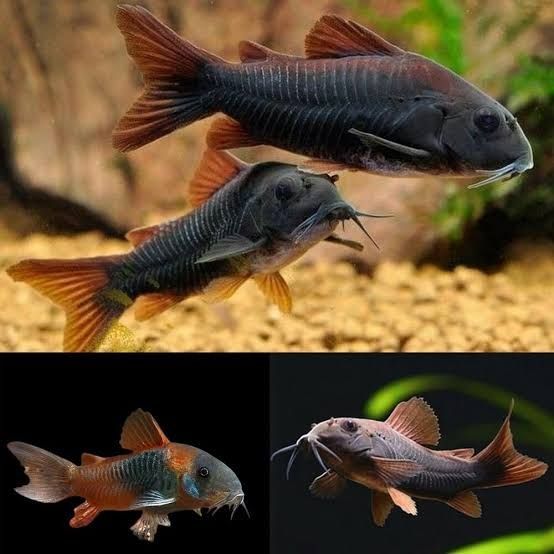Black Venezuelan Corydoras
The Black Venezuelan Corydoras (Corydoras venezuelanus) is a peaceful, bottom-dwelling catfish native to the waterways of Venezuela. They’re known for their striking black coloration and are a great addition to community tanks. Here's a guide to help you care for them:
Tank Setup:
-
Tank Size: A minimum of 20 gallons is recommended for a small group of Corydoras. The larger the tank, the better, as they prefer being in groups of 4–6 or more.
-
Substrate: These fish spend most of their time on the bottom, so soft, fine sand or smooth gravel is ideal. Avoid sharp or rough substrate that could damage their sensitive barbels.
-
Water Conditions:
-
Temperature: 72–78°F (22–26°C).
-
pH: 6.0–7.5 (slightly acidic to neutral).
-
Hardness: Soft to medium hardness, around 2–15 dGH.
-
-
Filtration: Ensure good filtration with a gentle water flow, as Corydoras are not strong swimmers and prefer calm water. Make sure the filter’s intake is covered to prevent them from getting sucked in.
-
Water Quality: Regular water changes (about 25-30% weekly) and good filtration will help maintain water quality. Use a liquid test kit to keep track of ammonia, nitrite, and nitrate levels, aiming for 0ppm ammonia and nitrite and under 20-30ppm nitrate.
Diet:
Black Venezuelan Corydoras are omnivores and will eat a variety of foods, including:
-
Pellets or sinking wafers designed for bottom feeders.
-
Frozen or live foods like brine shrimp, bloodworms, or daphnia.
-
Vegetables: Blanched zucchini, spinach, or peas.
-
They’ll also forage on any leftover food at the bottom of the tank.
Feed them small amounts 1-2 times per day, ensuring they have access to food that sinks to the bottom.
Tankmates:
These Corydoras are peaceful and do well with other non-aggressive, community tank species like:
-
Tetras
-
Livebearers (e.g., guppies, platys)
-
Small rasboras
-
Other peaceful bottom dwellers (like other Corydoras species) Avoid aggressive or fin-nipping species.
Behavior and Social Needs:
-
Group Behavior: Corydoras are social fish and thrive in groups. They are more active, confident, and visible when kept in groups of at least 4-6.
-
Bottom-Dwelling: They prefer to stay near the substrate, foraging for food and swimming slowly. They often like to "rest" on the bottom or hide in plants, caves, or driftwood.
Health:
-
Common Issues: Like other Corydoras, they are prone to "Ich" (white spot disease) and "fin rot", especially if water quality deteriorates.
-
Barbel Health: Make sure the substrate is smooth to prevent injury to their barbels, as damaged barbels can lead to infection.
Breeding:
Breeding Corydoras is not always easy, but it’s possible under the right conditions. They often need high water quality, a slightly cooler temperature, and a varied diet. If breeding is successful, eggs will be laid on flat surfaces, and the parents will typically leave them to hatch. The fry can be fed infusoria or baby brine shrimp.
Overall, Black Venezuelan Corydoras are hardy and easy to care for, as long as you maintain good water quality and provide them with the right environment and diet.
An interesting fact about Black Venezuelan Corydoras is that they are known to "school" with other species of Corydoras! While they prefer to be in groups of their own kind, they are not opposed to mingling with other Corydoras species in the same tank. They will often swim together in a coordinated manner, which is a fascinating behavior to watch. This group behavior helps them feel safer and more secure, as they’re naturally preyed upon in the wild. It's a great way to observe the social nature of Corydoras in a community tank!

